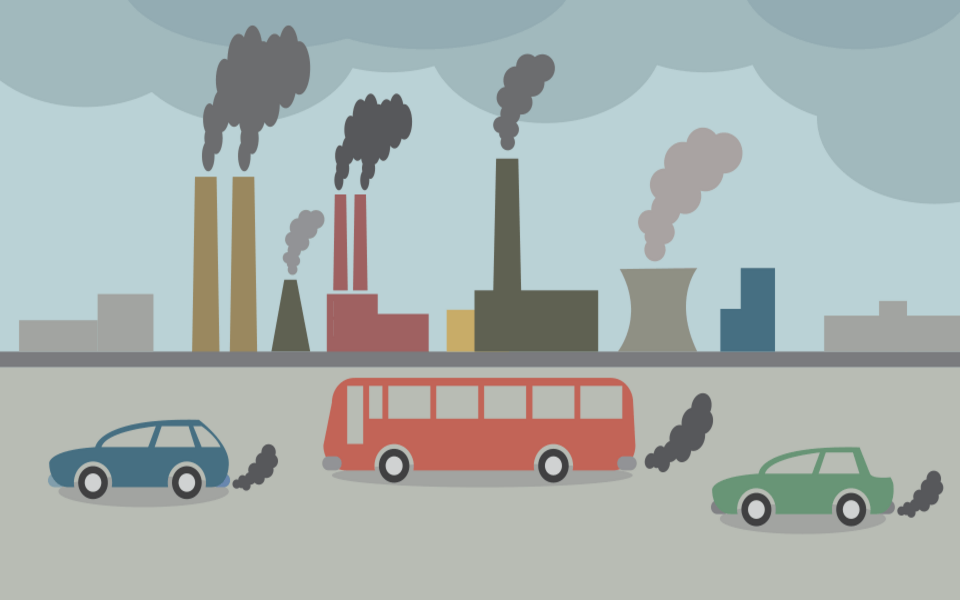Definition
Pollution is the introduction of pollutants into the environment. These harmful substances include gasses, and other substances. There are many kinds of pollution. Air pollution, water pollution, land pollution.
Table of Contents
- What is Air Pollution?
- Types of Air Pollutants
- Primary Pollutants
- Secondary Pollutants
- Causes of Air Pollution
What is Air Pollution?
Air pollution refers to the release of pollutants into the air—pollutants which are detrimental to human health and the planet as a whole. Smoke and nitrogen oxide produced from cars are examples of air pollutants.
Causes of Air Pollution
Following are the important causes of air pollution:
Burning of Fossil Fuels
To use fossil fuels we need to burn them and in that process they release nitrogen oxides into the environment thus creating smog and acid rain.
Automobiles
Automobiles also emit gasses that create a greenhouse effect and dangerous to human health as well.
Agricultural Activities
For agricultural activities farmers have to use insecticides, pesticides and fertilizers however these are made of chemicals which are then being exposed to atmosphere and pollute it. One of the most hazardous gas is Ammonia which is emitted during these activities.
Factories and Industries
Lately, we have started observing getting advisory about AQI (Air Quality Index) during the winter season. This is because our environment has been contaminated by the gases such as carbon monoxide, organic compounds, hydrocarbons and chemicals from factories and industries.
Mining Activities
Mining is the process of extracting minerals and other precious metals from earth using large equipment. During this process the chemicals are released into the environment which effects the air and also the health of the workers.
Domestic Sources
Anything that we use in our daily life from cleaning to paints contain toxic chemicals and are released in the air upon use. Some of these are less toxic than others however they all combined have a bad effect on the environment. Not only the environment, they also affect human health as well.
Effects of Air Pollution
There are countless hazardous effects on air pollution, some of them are:
Global Warming
Due to the emission of greenhouse gases, the gaseous composition of the air gets misbalanced which leads to change in temperature of the earth known as global warming. This results in extreme weather, shortage of water and other environmental issues.
Diseases
The low AQI (Air Quality Index) results in several respiratory and heart diseases among humans. Pneumonia, asthma and lung cancers are the common diseases found in people living near those polluted areas.
Acid Rain
When pollutants like nitrogen oxide mix with the air, they make the rainwater toxic. This kind of rain is known as acid rain.
Acid rain affects nearly everything. Plants, soil, trees, buildings, etc. Acid rain can be extremely harmful to forests. Acid rain that seeps into the ground can dissolve nutrients that trees need to be healthy. Acid rain also causes aluminum to be released into the soil, which makes it difficult for trees to take up water. It weakens them by washing away the protective film on leaves, and it stunts growth.
Ozone Layer Depletion
The ozone layer is an invisible layer of protective gases that circle the earth. The ozone layer stops most of the harmful ultraviolet rays, or UV rays, from hitting Earth. So if the ozone layer is damaged, the harmful rays get inside the earth and harm us and our environment. The release of chlorofluorocarbons, halons, and hydrochlorofluorocarbons in the atmosphere is the major cause of depletion of the ozone layer. It causes skin diseases and eye problems among individuals.
Air Pollution Control
Following are the measures one should adopt, to control air pollution:
Plantation:
The best source of reducing pollution and improving the air quality is to plant trees. Plant removes the toxic elements present in the air. Pakistan’s billion tree tsunami has been appreciated all over the world in this regard.
Clean Energy Resources
Using clean energy sources like solar, wind, water and geothermal energy minimizes air pollution. This helps in keeping the environment clean while being cost effective as well.
Conserve energy
Saving energy can result in low pollution as most of the electricity produced is through fossil fuels. Save energy, save environment.
Reduce automobile usage:
Use of private automobiles should be discouraged. A public transport not only prevents pollution but also conserves energy as well. In the modern time we are facing shortage of natural resources like oil and gas and saving these resources can have a good impact on both the environment and natural resources.
Environment Friendly Equipments:
Air pollution caused by industries can be controlled by using modern equipment that is environment friendly. These modern equipment help in minimizing the emission of pollutants.
Frequently Asked Questions
What is the major cause of air pollution?
Fossil fuel combustion is the main reason for air pollution. Harmful gases are released into the environment due to combustion of fossil fuels which pollutes the air.
What is land pollution?
When our waste products get scattered on the land, this causes pollution. Dumping plastic and construction work are a few examples of the cause of land pollution.
construction activities also occur, which result in large waste materials, such as metal, plastic, wood, and bricks. When these materials are not properly disposed of, it contributes to the land pollution of that area.
What is water pollution?
Water pollution is caused when harmful pollutants are added to the natural water sources.
Chemical waste and plastic trash are examples of water pollutants. It makes the water poisonous and damages the water bodies and kills the aquatic animals.
What are the most dangerous pollutants to the air?
CFCs or chlorofluorocarbons. CFCs contain, chlorine, fluorine, and carbon, and are very harmful to the environment. CFCs are harmful as they damage the ozone layer.
What is the ozone layer?
The ozone layer is an invisible layer of protective gases that circle the earth. The ozone layer stops most of the harmful ultraviolet rays, or UV rays, from hitting Earth. So if the ozone layer is damaged, the harmful rays get inside the earth and harm us and our environment.
How air pollution causes global warming?
In air pollution, the release of greenhouse gases changes the gaseous composition of the atmosphere and causes an increase in the temperature of the earth. This increased temperature of earth is known as global warming.
What is acid rain? Name the gases responsible for acid rain.
When pollutants like nitrogen oxide and sulphur oxides mix with the air due to the burning of fossil fuels, they make the rainwater toxic. This is called acid rain.
Acid rain affects nearly everything. Plants, soil, trees, buildings, etc. Acid rain can be extremely harmful to forests. Acid rain that seeps into the ground can dissolve nutrients that trees need to be healthy. Acid rain also causes aluminum to be released into the soil, which makes it difficult for trees to take up water. It weakens them by washing away the protective film on leaves, and it stunts growth.
What is Deforestation and how it becomes a reason for air pollution?
Removal of trees from forests in a large-scale manner if called deforestation. In the process of photosynthesis plants use an excessive amount of carbon dioxide present in the environment.



